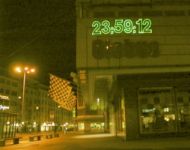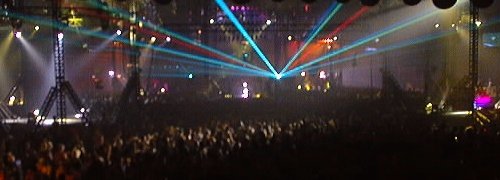|
|
Laser
Show Systems - Laser Show Production
How much
laser power do I need?
Introduction
Depending on the type of laser effects desired, different
output power is needed from the laser(s) used at a show. Your effects could
look spectacular or wimpy based on what type and power of lasers you are
using. This article gives some guidelines based on practical experience
for the power levels need to make different types of laser effects in
different venues.
Classes of
effects
The two main classes of effects used in laser shows can be divided
into screen effects and beam effects. Screen effects are any effect
that is projected onto a surface for viewing by the audience, Screen
effects include graphics, animations, abstracts, cycloids, optical and
grating effects. Beam effects are those effects created by projecting
the beam through the air and include static and dynamic beam effects,
sheets, cones, tunnels, fans, etc., and grating effects.
Generally speaking, screen effects require much less power than beam effects
as the projection surface serves to reflect the light towards the viewers
eyes. Beam effects take considerably more power as they have to
illuminate many particles of dust or haze suspended in the air in order to
make the beam(s) visible to the audience.
|

A half watt 532 YAG laser used to
project a laser clock on the side of a building at night -
Photo courtesy of Laser Quantum
|
Screen
Effects
As motioned above, screen effects take considerably less
power to produce than laser beam effects. To make a good screen image,
you need a contrast ratio of about 100:1. This means that the image
has to be 100 times brighter than the background [projection surface].
To make a high quality laser image, one that gives the illusion of being
almost three dimensional and floating off the screen, you need a contrast
ratio of 250:1 to 300:1.
Fortunately, laser graphics inherently conserver photon energy when compared
to other forms of display such as slides, movies or video. In those
forms of display, the entire image generating surface [the film or light
control element in a video projector] must be fully illuminated with an even
light, even though part, or even much, of the mage on the screen may be
black. Vector laser graphics only put light where it is needed to form
the image.
In a controlled lighting situation such as a theatrical setting where almost
total darkness can be obtained, large laser images can be made with relatively
low power lasers. Graphics up to 20 X 20 feet [6 x 6 meters] can be
made with as little as 250 mW of laser power. Note that the 250 mW is light delivered
to the screen; you will have to start with a higher power laser to take into
account losses in the PCAOM and optics. Naturally a smaller image can be
made with less power.
As the light level in the venue increases, higher laser powers are
needed. In an industrial trade show situation where an image must be
projected in a venue lit with fluorescent or mercury vapour lights, 3 to 5
watts may be needed to make an image 10 X 10 feet [3 X 3 meters].
The quality of the projected image is also dependant on the projection
surface. The ideal projection surface for laser is not a white screen
[unless you have a very low power laser and need to reflect as much light as
possible]. White screens are highly visible to the audience as they
reflect any scattered light in the venue [even exit signs and isle lighting
in theatrical settings]. White screens also tend to make the image
look slightly 'washed out' and it is more difficult to get the 'image
floating in front of the screen' effect.
The best projection surface is one that is about 18% gray so that some light
is absorbed and little of the ambient light in the venue is reflected.
This means that the typical rear projection screen made of translucent gray
plastic is the preferred surface - even in front projection applications.
Often one has to work with existing surfaces such as the side of building
which are less than optimal. In those cases, one has to scale the
laser power upwards to make an image with a high contrast ratio, and may
have to adjust the colour palette of the graphics system so as to compensate
for the background colour of the building surface if it is not white to gray
in colour as otherwise the colours in the image will be affected by the
projection surface.
|

|
|
A fan of beams effect in a very
large arena for a party with 25,000 people. In order to make
this spectacular effect, a 10 watt colour laser system was used and
there were 4 MDG MAX5000 hazers in continuous use within the venue. |
Beam Effects
It is possible to make good beam effects with as little as
250 mW of laser power provided you have absolute darkness and a good
haze. In conditions where there is other lighting in the room, such as
in clubs and bars, at least 1 watt of power and a good haze is required to
make acceptable beam effects; 2 to 3 watts are needed to make impressive
beam effects. For truly spectacular beam effects in those conditions,
5 or 8 watts of laser power would be required.
For beam effects in well lit trade shows, large arenas and stadiums, more
laser power is required. In an indoor venue, 4 to 6 watts will make
good beam effects with a proper haze provided ambient lighting is not
high. For outdoor venues where the haze can not be counted on to say
in place, 10 to 20 watts or even more would be required.
The visibility of beam effects is also dependant on two other major factors
- viewing angle and haze. The beam should be as close to the viewing
axis of the audience as possible while respecting safety requirements. This means that the audience should
be facing the source of beam projections and the beams should be as close
over their heads as is legally possible given the power level of the
laser. Note that static beams should never be projected into an
audience and scanned beam effects should be of low enough power density so
as not to cause afterimages in the viewers eyes. [See the article entitled Making Shows Safe And Enjoyable
for more information.]
The other factor affecting beam visibility is the quality of the haze in the
venue. Water based machines make impressive thick clouds of smoke but
these both block the beams, and dissipate rapidly. A fine, almost invisible,
haze is the best for beam effects as it does not block the beam diminishing
it's visual effects, but rather makes the beam visible along more of it's
length. A professional quality hazer such as the MDG MAX3000 or
similar with a fan would be adequate for venues up to a small of medium
sized arena. For larger spaces, the MDG MAX5000 with a fan, or even a
few MAX5000s with fans would be required. The best strategy is to turn
on the hazer(s) on before the audience arrives and to keep them running at a
slow but steady rate during the presentation, using the fans to disperse the
haze.
It is preferable to blow the haze to the side of the laser beam paths and
allow it to disperse throughout the venue unless 'texture' effects in the beam
are desired. In that situation, it is best to place a hazer below and
in front of the laser position and blow the smoke out below the beam path
allowing it to rise into the beams by convection. [For more
information on hazers see Smoke Machines Vs. Hazers.]
NOTE: The power levels mentioned
above are presuming the use
of an argon or white light laser system. Other types of lasers such as
Copper vapour and 532 YAG lasers have much higher apparent brightness due to
the sensitivity of the human eye so will appear brighter for the same power
levels mentioned. YAG lasers of three times less power, or CV lasers
of half the power mentioned above can be used to
make these effects..
DISCLAIMER:
Some of the information in the Backstage area is provided by the persons or
companies named on the relevant page(s). Laser F/X does NOT endorse or
recommend any products/services and is NOT responsible for the technical
accuracy of the information provided. We provide this information as a
service to laserists using the Backstage area.
[
Introduction - System
Design - Scanning Systems
- Support
Equipment - Laser
Graphics - Show
Production - Pinouts ]
|